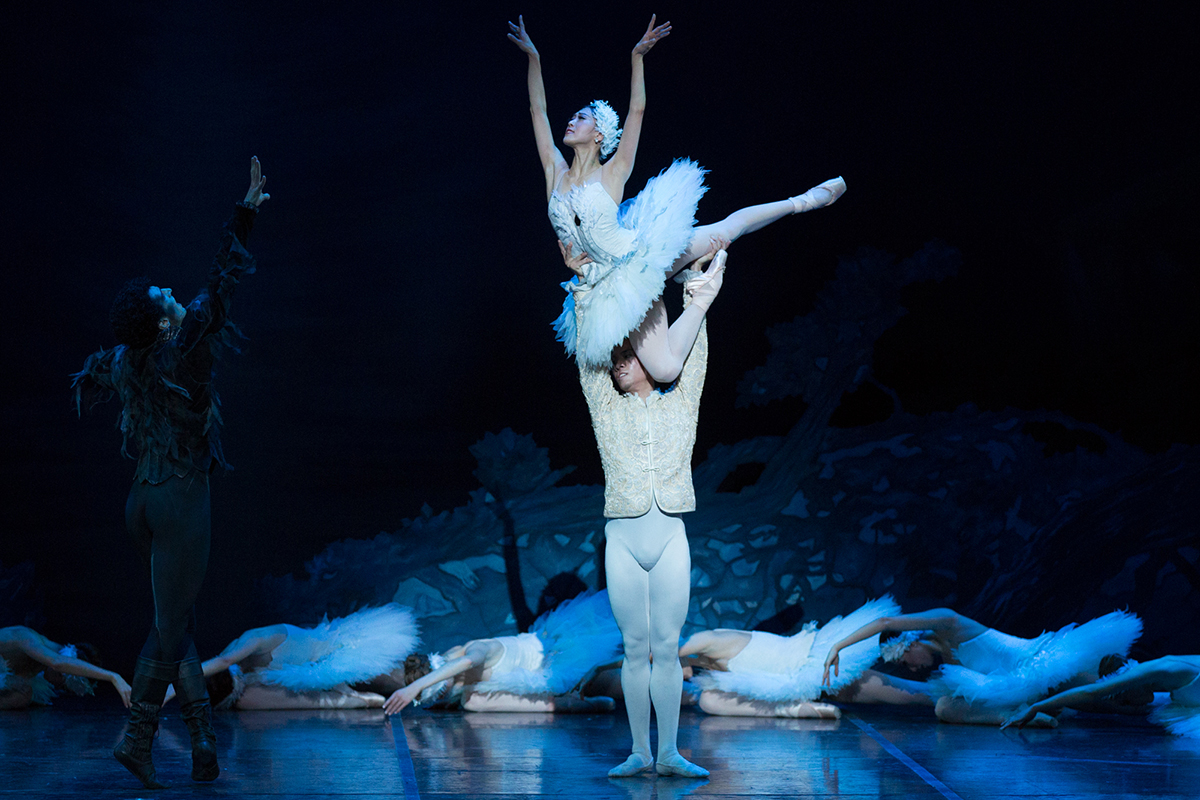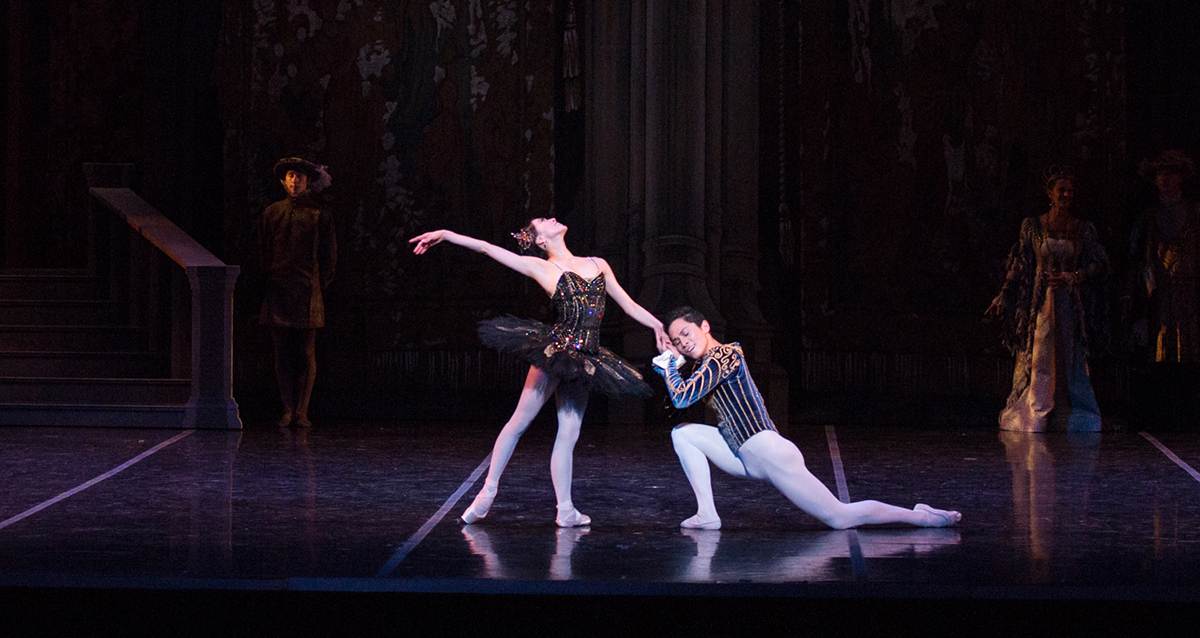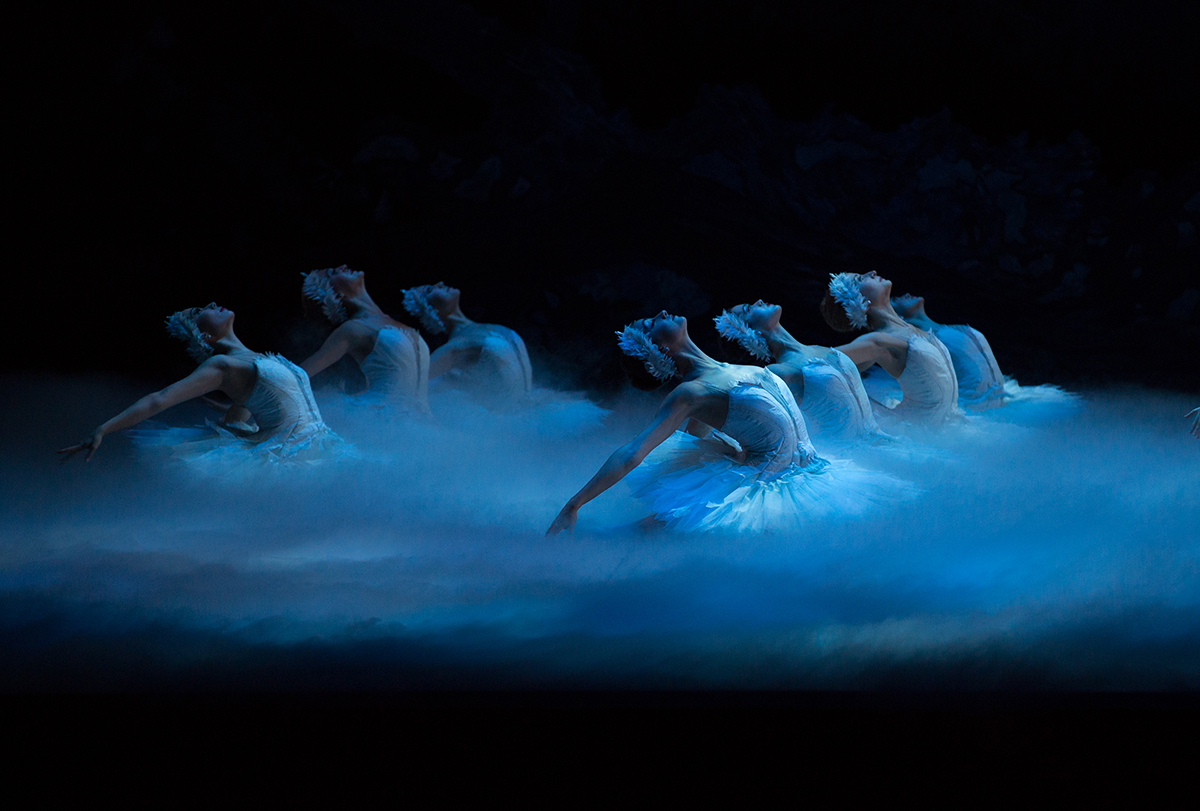Misa Kuranaga Talks Swan Lake

Misa Kuranaga as the Swan Queen, Odette, with Lasha Khozashvili and Jeffrey Cirio. / Photo by Rosalie O’Connor courtesy of Boston Ballet
“It’s my goal is to make everybody else dizzy,” says Misa Kuranaga of her show-stopping 32 fouettes in Swan Lake. “I love them so much.” Along with the winglike arms and the cygnets’ dance, the Black Swan’s repetitive turns in Act 3 are an iconic part of Tchaikovsky’s classic ballet.
Kuranaga makes it look easy—and indeed gives the audience whiplash. But even though she trained to do 64 consecutive up-and-down spins on one leg, she says 32 fouettes is still quite the physical challenge after dancing more than half the show and the pas de deux.
A longtime principal with Boston Ballet, Kuranaga will once again bring the Swan Queen, Odette, and the Black Swan, Odile, to life this weekend at the Boston Opera House. A week before opening night, Kuranaga spared a break between rehearsals to discuss this season’s production.
It’s the second time you’re playing Odette and Odile in Mikko Nissinen’s version of Swan Lake. How will this year be different from 2014?
Everything is very different this year. First, I’m not dancing with the same partner. Then, the partner whom I was going to dance with unfortunately had to bow out at the last minute [due to injury]. I’ll perform with a guest artist [Gonzalo Garcia], but he dances with New York City Ballet, so he’s not here right now.

Misa Kuranaga as the Black Swan, Odile, with previous partner Jeffrey Cirio in 2014. / Photo by Rosalie O’Connor courtesy of Boston Ballet
Have you been able to practice with Gonzalo at all?
Just a few times, maybe a few hours. [Laughs] It’s not ideal to have no partner until the week that we’re performing. He’s coming two days before the premiere. But you know, this is what I’ve got this year, and Gonzalo is an amazing artist, amazing dancer, amazing person, so I feel totally comfortable and I’m so happy to dance with him. But yes, it is a very different situation this year.
Another difference is that last year we had Swan Lake in the beginning of the season. We were all fresh and only working on Swan Lake for two months. This year, we’re doing it at the end of the season with the mixed program, Mirrors. The second week and on, we’re going to be mixing in and out—maybe Mirrors for the matinee, Swan Lake at night, and again the next day, something like that. For dancers, it’s a really hard thing to do, coming from contemporary to putting your body into classical ballet shape. It really has been a difficult process this year, I must say.
On top of that, you have to switch back and forth between playing Odette and Odile too.
Well, that’s not a problem at all. For me, the artistic part is fine as long as I’m given a proper rehearsal hour and proper rehearsal classes. But this year has been a difficult process for everybody because of lack of studio and rehearsal time for Swan Lake. Ever since Mikko took over, I don’t think the company has tried anything like this before. This is a new [experiment]—I think it was mostly for the purpose of ticket sales, but for the dancers it’ll be really challenging. Actually, this season, the only thing that hasn’t changed is the choreography. [Editor’s note: The ballet notes that the vision for the alternating shows is to give audiences a greater mix of shows to see.]
In addition to the fouettes, another iconic move is the beautiful fluttering of the swan arms. How difficult is it to master that?
Swan Lake, of course, is so unique because of the arms and because of the different upper body shapes. I almost think Swan Lake is half contemporary and half classical because from the waist to your toes, you have to be super academic-classic, but the upper body needs to be super contemporary. Your chest has to be forward and your arms have to go back to create that shape. You just don’t see that in Sleeping Beauty and Giselle. That arm being behind your ear and shoulder—you have to be flexible enough to do it. Boys can never do that because they have bigger muscles. This is a special thing that only women can do. It took me a month to put the arm movements in my nerve system, my muscle memory.

Photo by Rosalie O’Connor courtesy of Boston Ballet
Do you relate more to Odette or Odile?
I can relate to both—I think any human being can have a good side and bad side, weak side and strong side, sensitive side and confident side. Maybe not over-the-top manipulative and seductive, but I can relate to both. Day-to-day, hour-to-hour, I feel like this, I feel like that. So when people ask me if it’s a difficult switch, I say “no,” because both are in me.
Is one more difficult for you to dance than the other?
White, because of the swan arm shape. The black “swan” is not actually a swan, so the choreography is constructed more like an academic classical ballet. For that reason, for me, the White Swan is harder. Maybe someone else would find the black more difficult because of the technical turns, but for me, white.
You’ve been a principal for many years now. Are there any dream roles you haven’t performed yet?
You know, I’m really lucky that I’ve done almost all the classical ballet repertoires that I’ve dreamt to do since I was little. One or two I haven’t done are Le Corsaire, a super-classical ballet I get to do next year. I would also love to do [Kenneth] MacMillan’s Manon or John Neumeier’s Lady of the Camellias, or MacMillan’s Romeo and Juliet.
What’s your favorite thing about dancing for Boston Ballet?
The wide range and well-balanced repertories. I get to explore all the classical ballets, neoclassical like Balanchine and Forsythe, work with many other choreographers, plus the contemporary pieces. Also, I love my coach Larissa Ponomarenko. She used to be a ballerina here—and she was the most beautiful Swan Queen actually. In the ballet world, coaching is one of the most difficult things to do, and a lot of companies are lacking that. For me, Larissa is a coach I can connect with. She pulls so much out of me, technically, artistically, and she always tries to make me do more.
Contrary to the stereotype, ballet dancers do eat. Where do you like to go in Boston?
Of course. Food is a source of energy. We do eight hours a day including class. If we don’t eat, it’s dangerous—you could get injured or get sick. That’s my strong message to young dancers. I tell them, “You need to eat.” I like oysters a lot, so I go to oyster bars like Island Creek or B&G Oysters.
Any favorite Japanese restaurants?
I like Ittoku in Allston—tapas-style plates. It’s run by a Japanese owner, and almost everyone’s Japanese there, so they do it right, you know? A lot of Japanese places in Boston are run by non-Japanese, so some things are kind of strange…because I know, I’m from Japan, like, “Oh, this isn’t really Japanese.” [Ittoku] is one of the most authentic Japanese places in Boston for now.
Misa Kuranaga will play Odette/Odile with guest Gonzalo Garcia April 29 and 30. Swan Lake runs April 29-May 26 at the Boston Opera House. For details and tickets, go to bostonballet.org.


